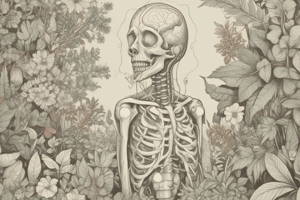Podcast
Questions and Answers
What type of microtome is used primarily for electron microscopy sections?
What type of microtome is used primarily for electron microscopy sections?
- Ultra microtome (correct)
- Freezing microtome
- Sliding microtome
- Rotary microtome
Which of the following is an advantage of using freezing microtomes?
Which of the following is an advantage of using freezing microtomes?
- Ability to cut thin serial sections
- Preservation of enzyme activity in tissues (correct)
- Utilization of rotary motion for accuracy
- Consistent staining of sections
What distinguishes a rotary microtome from a sliding microtome?
What distinguishes a rotary microtome from a sliding microtome?
- More suited for wet preparations than dry preparations.
- The specimen remains stationary while the razor moves.
- The razor is fixed while the specimen moves. (correct)
- Primarily used for non-section preparations.
Which of the following preparations is NOT associated with dry preparation methods?
Which of the following preparations is NOT associated with dry preparation methods?
What is a major disadvantage of using freezing microtomes?
What is a major disadvantage of using freezing microtomes?
Which type of botanical preparation includes bulk specimens and herbarium sheets?
Which type of botanical preparation includes bulk specimens and herbarium sheets?
What technique is appropriate for sectioning too soft or fragile tissues?
What technique is appropriate for sectioning too soft or fragile tissues?
Which method is used for preparing specimens that require chemical treatment for tight tissues?
Which method is used for preparing specimens that require chemical treatment for tight tissues?
Which of the following is a disadvantage of using freezing microtomes for sectioning?
Which of the following is a disadvantage of using freezing microtomes for sectioning?
What type of preparation involves peeling epidermal cells manually or with a sharp blade?
What type of preparation involves peeling epidermal cells manually or with a sharp blade?
Which mounting technique is primarily used for electron microscopy?
Which mounting technique is primarily used for electron microscopy?
What is the primary advantage of using sectioning with sliding microtomes?
What is the primary advantage of using sectioning with sliding microtomes?
Which botanical preparation method would be used to prepare specimens like yeast or bacteria?
Which botanical preparation method would be used to prepare specimens like yeast or bacteria?
Flashcards
Macroscopic Preparation
Macroscopic Preparation
A botanical preparation that is visible to the naked eye without magnification.
Microscopic Preparation
Microscopic Preparation
A botanical preparation that requires a microscope to view details.
Sectioning (of tissues)
Sectioning (of tissues)
A technique for preparing plant tissues for microscopic study by slicing into thin sections.
Dry Preparation
Dry Preparation
Signup and view all the flashcards
Herbarium Sheet
Herbarium Sheet
Signup and view all the flashcards
Whole Mount Preparation
Whole Mount Preparation
Signup and view all the flashcards
Smear Preparation
Smear Preparation
Signup and view all the flashcards
Sectioning of Embedded Tissues
Sectioning of Embedded Tissues
Signup and view all the flashcards
Rotary Microtome
Rotary Microtome
Signup and view all the flashcards
Freezing Microtome
Freezing Microtome
Signup and view all the flashcards
Paraffin Technique
Paraffin Technique
Signup and view all the flashcards
Sectioning Microtomes
Sectioning Microtomes
Signup and view all the flashcards
Types of Microtomes
Types of Microtomes
Signup and view all the flashcards
Study Notes
Genetics (B252) 2020/2021
- Course code: B252
- Academic year: 2020/2021
Types of Botanical Preparations
- i-Non-section preparation
- A-Macroscopic preparation
- 1-Dry preparation
- Bulk specimens
- Herbarium sheets
- 2-Wet preparation
- Museum jar
- 1-Dry preparation
- B-Microscopic preparation
- 1-Whole mount prep.
- 2-Smear prep.
- 3-Squash prep.
- 4-Macerated prep.
- 5-Teased prep.
- 6-Peeling of epidermal cells
- A-Macroscopic preparation
- ii-Section preparation
- Sectioning
- A-Sectioning of unembedded tissues
- B-Sectioning of embedded tissues
- 1-Paraffin technique
- Rotary type
- 2-Celludin technique
- Sliding type
- 3-Electron microscopy technique
- Ultra type
- 1-Paraffin technique
- Sectioning
- iii-Cell and tissue culture
Herbarium Sheet
- Dry preparation
- Macroscopic preparation
- Non-section preparation
- Straps
- Outer boards
- Plant press (Fig. 24.6 (b))
Bulk Specimens
- Dry preparation
- Macroscopic preparation
- Non-section preparation
Museum Jar
- Wet preparation
- Macroscopic preparation
- Non-section preparation
Microscopic Preparations
- Filamentous form (e.g., Spirogyra): Whole mount prep.
- Thalloid forms: Whole mount prep.
- Fluid or semifluid (e.g., yeast, diatoms, pollen grains, bacteria): Smear prep.
- Soft tissues (e.g., Feulgen squash technique): Squash prep.
- Tight tissues: Chemical treatment (e.g., hydrolysis of root tips by HCl)
- Fibrous tissues (e.g., 2ry thickening in xylem vessels): Teased prep.
- Peeling of epidermal cells (e.g., bean): Manually with sharp blade (e.g., scalpel, razor)
- Peeling of epidermal cells (e.g., Zea): Manually with a sharp blade (e.g., scalpel, razor)
- Stone cells in Guava: Squash prep.
Types of Microtomes
- 1-Sliding types
- Specimen fixed
- Razor moving (horizontally)
- 2-Rotary types
- Specimen moving (vertically)
- Razor fixed
- 3-Special types (for specific studies)
- a-Ultra microtome
- Rotary type (electron microscopy sections)
- b-Freezing microtome
- Freezing agent (solid CO2 or dry ice)
- Sliding type
- Rotary type (cryostat)
- a-Ultra microtome
A-sectioning of unembedded tissues
- 1-Free hand sectioning
- Rigid tissues (e.g., T.S. in a young stem)
- 2-Sectioning with sliding microtomes
- Stiff tissues (difficult to cut by free hand)
- 3-Sectioning with freezing microtomes
- Too soft or fragile tissues
- Enveloped in fluid or semifluid medium (external supporting material)
Sectioning with Freezing Microtomes
- Advantage: Quick, preserves chemistry of tissues to demonstrate enzyme activity
- Disadvantage: Non-serial sections, thick sections, difficult to cut and stain
B-sectioning of embedded tissues
- 1-Paraffin technique
- Rotary type
- 2-Celludin technique
- Sliding type
- 3-Electron microscopy technique
- Ultra type
Studying That Suits You
Use AI to generate personalized quizzes and flashcards to suit your learning preferences.




